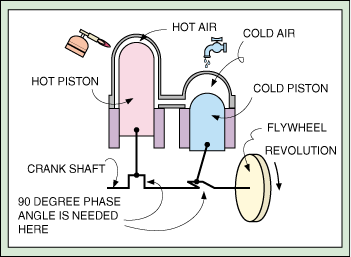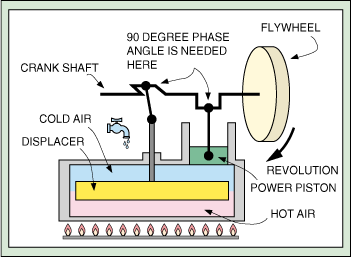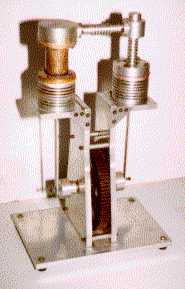TWO PISTON TYPE STIRLING ENGINE

In 1817 the Scottish minister Robert Stirling invented
a "hot-gas motor".
Stirling engines theoretically achieve the highest possible energy conversion
efficiency of all heat engines. They can use any kind of energy and used
as a generator, motor, heat-pump or cooling system they produce extremely
low emissions. Nevertheless the Stirling engines have still not achieved
commercial breakthrough as a mass product.
Stirling engines as thermodynamic machines are subject to the law of Carnot, ideally achieving the efficiency (n):
n(th)=(T1-T2)/T1
T1 is the higher temperature in °K
T2 is the lower temperature in °K
With increasing temperature differences the theoretically achievable thermodynamic efficiency increases toward 100%. The development of Stirling engines over the last decades has focused on constructing high-efficiency machines through high temperature differences. The result were Stirling engines filled with helium/hydrogen and sealed, working with temperatures of up to 800°C, with a pressure of 50 to 190 bar.
TWO PISTON TYPE STIRLING ENGINE

DISPLACER TYPE STIRLING ENGINE

Source: Stirling engine homepage
Model of a Stirling Engine

Source: Stirling engine homepage
Because of the high temperature, pressure and frequency for high-performance Stirling engines the costs are very high. The present trend is to build Stirling engines involving temperatures in excess of 1,000°C at the hot end and toward the employment of new materials (ceramic, special metals) and improved manufacturing technologies.
Sources:BOMIN SOLAR, SIGNON SAN DIEGO, FUTURE DRIVE, WORLD WATCH.
Back to CONVENTIONAL COMBUSTION ENGINES
or CAR OF THE FUTURE